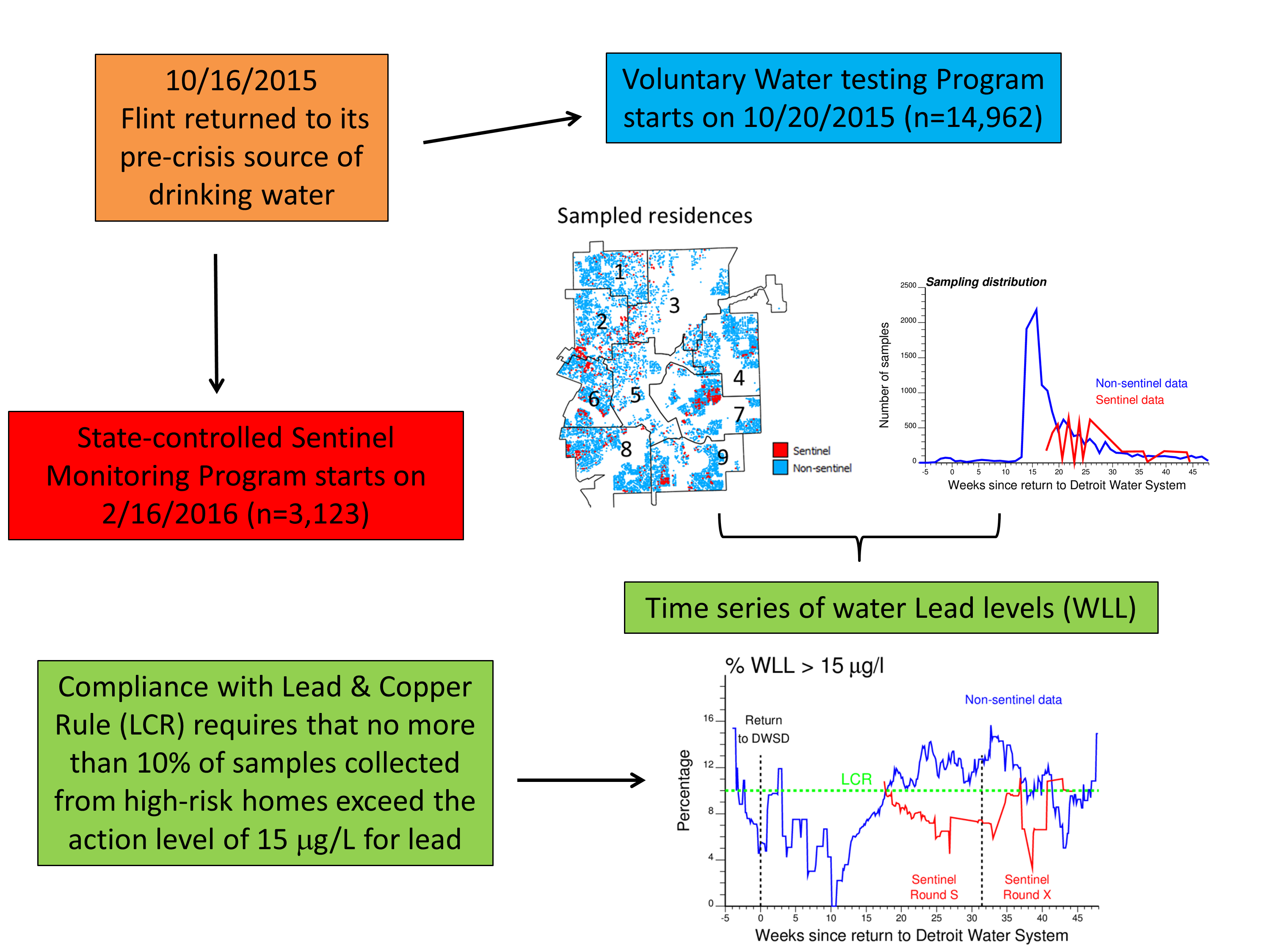Flint Water Crisis
Flint Water Crisis
Background
The drinking water contamination crisis in Flint, Michigan has attracted national attention since extreme levels of lead were recorded following a switch in water supply that resulted in water with high chloride and no corrosion inhibitor flowing through the aging Flint water distribution system. The resulting contamination increased significantly the number of children with elevated blood lead levels and an emergency response was initiated, leading the city to switch back to its pre-crisis water supply on October 16, 2015.
During the first eleven months following Flint’s return to its pre-crisis source of drinking water, close to 25,000 water samples have been collected almost daily, mainly by homeowners using two different sampling initiatives. The majority of these samples (80%) were collected through a voluntary or homeowner-driven sampling whereby concerned citizens decided to acquire a free testing kits available to residents at local water distribution centers and conduct sampling on their own (non-sentinel sites). Starting four months later (2/16/2016) samples were also collected bi-weekly at more than 600 sentinel sites chosen by the EPA and Michigan Department of Environmental Quality (MDEQ) across the city to determine the general health of the distribution system and to track changes in lead concentrations over time. Sentinel teams including a member of MDEQ, a licensed plumber and a community member visited the houses selected to be part of the sentinel network. A plumbing inspection was conducted to verify the service line material entering the home and residents were shown how to draw samples of their water in a scientifically accurate manner.
The Lead and Copper Rule sampling is intended to measure the lead and copper levels in drinking water to assess the effectiveness of corrosion control treatment utilized by public water systems. Under that rule, first-draw 1-L water samples must be collected after a minimum of 6 hrs. of stagnation (e.g., overnight stagnation) and without pre-flushing the tap prior to the stagnation period (i.e., no pre-stagnation flushing). Compliance with that rule requires that no more than 10% of samples collected from high-risk homes exceed the action level of 15 µg/L for lead and 1.3 mg/L for copper. If non-compliance is observed the system must undertake a number of additional actions to control corrosion. If the action level for lead is exceeded, the system must also inform the public about steps they should take to protect their health and may have to replace lead service lines under their control.
Objectives
The objectives of this project were:
- create a reliable space-time database of water lead levels (WLL) in Flint matching each observation with a tax parcel unit where housing characteristics (e.g., presence of lead service lines, built year) are available
- identify by exploratory data analysis and Generalized Estimating Equations (GEE) a few easily accessible variables that influence the likelihood of WLL above 15 µg/L and use this information to correct for potential sampling bias.
- estimate the timing and rate of change in the percentage of water samples above 15 µg/L using joinpoint regression.
- explore the impact of the type of sampling program (sentinel vs non-sentinel) and geographical location on the results.
Results
- A key finding of the present study was that even after adjusting for housing characteristics samples collected at sentinel sites exceeded water lead levels of 15 µg/L and higher at a statistically significant lower rate than samples collected on a voluntary basis by homeowners (non-sentinel sites).
- GEE regression conducted for WLL thresholds ranging from 1 to 50 µg/L provided important information on the relative influence of housing characteristics. The built year (e.g., pre vs post-1940) turned out to be the main risk factor, whereas the presence of lead service lines is mostly important for smaller thresholds (e.g., 1 µg/L).
- Despite the recent improvement in water quality, the culprit for differences between sampling programs needs to be identified as it impacts exposure assessment and might influence whether there is compliance or not with the Lead and Copper Rule.

Publication
Goovaerts, P. 2016. The drinking water contamination crisis in Flint: Modeling temporal trends of lead level since returning to Detroit Water System. Science of the Total Environment, in press.